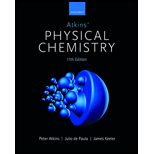
Concept explainers
(a)
Interpretation:
The entropy of mixing of a gaseous mixture with mass percentage composition
Concept Introduction:
In the mixing of two or more perfect gases the entropy of mixing is calculated by the formula below.
The value of
(a)
Answer to Problem 5A.3P
The entropy of mixing of a gaseous mixture with mass percentage composition
Explanation of Solution
The entropy of mixing of perfect gases (
Where,
The mass percentage of
Therefore, the mole fraction of
The mass percentage of
Therefore, the mole fraction of
The mass percentage of
Therefore, the mole fraction of
Therefore, the entropy of mixing
Therefore, the entropy of mixing of a gaseous mixture with mass percentage composition
(b)
Interpretation:
The change in entropy from part (a) when air is taken as a mixture with mass percentage composition
Concept Introduction:
Refer to (a)
(b)
Answer to Problem 5A.3P
The change in entropy from part (a) when air is taken as a mixture with mass percentage composition
Explanation of Solution
The entropy of mixing of perfect gases (
Where,
The mass percentage of
Therefore, the mole fraction of
The mass percentage of
Therefore, the mole fraction of
The mass percentage of
Therefore, the mole fraction of
The mass percentage of
Therefore, the mole fraction of
Therefore, the entropy of mixing
Therefore, the entropy of mixing of a gaseous mixture with mass percentage composition
Therefore, the change in entropy from part (a) is calculated below.
Want to see more full solutions like this?
Chapter 5 Solutions
Atkins' Physical Chemistry
 ChemistryChemistryISBN:9781305957404Author:Steven S. Zumdahl, Susan A. Zumdahl, Donald J. DeCostePublisher:Cengage Learning
ChemistryChemistryISBN:9781305957404Author:Steven S. Zumdahl, Susan A. Zumdahl, Donald J. DeCostePublisher:Cengage Learning ChemistryChemistryISBN:9781259911156Author:Raymond Chang Dr., Jason Overby ProfessorPublisher:McGraw-Hill Education
ChemistryChemistryISBN:9781259911156Author:Raymond Chang Dr., Jason Overby ProfessorPublisher:McGraw-Hill Education Principles of Instrumental AnalysisChemistryISBN:9781305577213Author:Douglas A. Skoog, F. James Holler, Stanley R. CrouchPublisher:Cengage Learning
Principles of Instrumental AnalysisChemistryISBN:9781305577213Author:Douglas A. Skoog, F. James Holler, Stanley R. CrouchPublisher:Cengage Learning Organic ChemistryChemistryISBN:9780078021558Author:Janice Gorzynski Smith Dr.Publisher:McGraw-Hill Education
Organic ChemistryChemistryISBN:9780078021558Author:Janice Gorzynski Smith Dr.Publisher:McGraw-Hill Education Chemistry: Principles and ReactionsChemistryISBN:9781305079373Author:William L. Masterton, Cecile N. HurleyPublisher:Cengage Learning
Chemistry: Principles and ReactionsChemistryISBN:9781305079373Author:William L. Masterton, Cecile N. HurleyPublisher:Cengage Learning Elementary Principles of Chemical Processes, Bind...ChemistryISBN:9781118431221Author:Richard M. Felder, Ronald W. Rousseau, Lisa G. BullardPublisher:WILEY
Elementary Principles of Chemical Processes, Bind...ChemistryISBN:9781118431221Author:Richard M. Felder, Ronald W. Rousseau, Lisa G. BullardPublisher:WILEY





